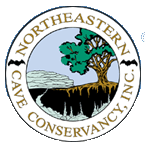



Statement on Regional Cave Openings
and Efforts to Contain the Spread of White Nose Syndrome
May 15, 2009
The following statement was prepared following a meeting May 6, 2009 attended by representatives of the U.S. Fish and Wildlife Service(USFWS), New York Department of Environmental Conservation (NYDEC), the Northeastern Cave Conservancy (NCC), National Speleological Society (NSS) New York Nature Preserve Managers, and the National Speleological Society White Nose Syndrome Liaison.
The Northeastern Cave Conservancy and the National Speleological Society’s New York cave managers announced that their New York caves will open on May 15, 2009. Cave visitation will be subject to the usual conditions, including any group use permits, waivers, and proper equipment and experience. All cave visitors are asked to follow the cleaning and decontamination procedures of the U.S. Fish and Wildlife Service, which can be found at: http://www.fws.gov/northeast/whitenosemessage.html. In addition, no gear or clothing used in these caves should be taken outside the region.
NCC Caves opening are: Clarksville, Ladder, Onesquethaw, Knox, Crossbones, Ella Armstrong, Selleck’s, Levy’s, and 545. Information on visitation conditions can be found at http://www.necaveconservancy.org/default.php.
NSS Cave openings are: Schoharie Caverns, Barton Hill (Gage’s Cave, Keyhole Cave, and Green Cave), and the McFails Preserve caves (McFails, Hanor/Disappointment, and Featherstonaugh’s Flop). Information for these preserves may be found at http://www.caves.org/preserves/.
In its Advisory, the USFWS urged “agencies and partners who manage cave resources to strongly consider limiting access to caves and mines to slow the spread of WNS,” and encouraged “national and local caving organizations to continue their outreach and education efforts to spread the word about WNS and about responsible resource stewardship.”
To that end, on March 29, 2009, the NCC closed all its caves until May 15. The NSS caves had previously been closed for the winter. All of the NSS caves and some of the NCC caves maintained hibernating bat populations that had been decimated by White Nose Syndrome. The winter closures protect surviving bats from disturbance, hopefully supporting successful reproduction and the rebuilding of bat colonies. As these bats typically give birth to only one pup per year, full population restoration will take years.
The NCC and the NSS believe it is imperative to do whatever we can to contain the spread of WNS, including minimizing any potential human vector. While it is clear that bats are likely the primary source of WNS transmission to other bats, and human transmission is not proven, nor likely easy, staying out of caves within the Advisory area for the time being is clearly the best way to minimize any potential for humans to inadvertently spread WNS.
However, other management and education considerations must be taken into account. If these caves remained closed, there is evidence that it encourages local cavers to travel elsewhere for caving. This increases the possibility of caving gear used in WNS-affected sites to be taken out of the region. It also encourages local cavers to seek access to other local privately-owned caves that may be more environmentally fragile, or more dangerous, increasing the possibility of cave rescue.
Further, as all of these caves either are already WNS-affected sites, or do not contain bats, no further damage to these caves or their bats would occur, especially in the summer, when bats are gone from hibernation. Continued closure would also have increased the risk of vandalism, a concern raised by property managers and adjoining landowners, and enforcement is difficult, if not impossible.
In addition, there are 105 youth and other groups that regularly visit these caves, where we have kiosks, managers, permits, and the ability to interface with thousands of individuals who are not members of the organized caving community. Educating them about WNS, as well as caves, karst, groundwater, and safe caving techniques, would be missed without that contact. We would forego all of these opportunities if the caves remained closed.
The NSS has prepared a special information brochure on WNS, which the NCC has printed and will be available at the cave properties. It is also available for download on both the NCC and NSS websites: http://www.necaveconservancy.org , or http://www.caves.org/WNS/index.htm .
In conclusion, we all agreed that keeping people caving locally is better than creating a situation where people feel compelled to travel elsewhere. As no additional harm would occur to caves or bats locally, providing local outlets for caving lessens the potential spread to uncontaminated areas in other parts of the country.
Please note that the status of these caves is subject to change. Those that normally close for the winter to protect hibernating bats according to their management plans will do so October 15. It is always wise to check the NCC or NSS websites for these caves prior to any trip for the latest information.
Finally, we continue to stress that any local cavers traveling outside the region to cave not take any gear or clothing that has been exposed to a WNS-affected cave. Buy new, if you can, or borrow locally. Thank you for your cooperation.